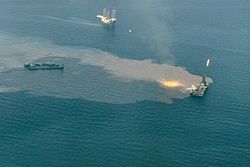 Spill Size/Extent
Spill Size/ExtentSize: 30,576,000 gallons
Continuing rate of spill: 1,092,000 gallons per day.
More details:
Analysis of aerial photographs by Skytruth on May 15 indicated slicks and sheen covering an area of about 4,922 square miles. There are some indications that the edge of the oil slick may be
entering the “loop current” that would take it toward the Florida Keys and potentially up the East Coast.
More on this.
Today (May 18) there were reports of oil washing up on the beach in Waveland, Mississippi and tar balls were found by park rangers at
Fort Zachary Taylor State Park and nearby Navy beach at Truman annex in Key West, Florida. [Update: the tar balls found in Key West have been determined not to be from the Deepwater Horizon oil well blowout.] Oil has previously been reported hitting the beach at South Pass, near Port Eads, Louisiana and also on the Chandeleur Islands. Earlier reports documented oil on Dauphin Island, Alabama.
State of Efforts to Stop Flow
BP has put a mile-long 4-inch diameter “insertion tube” into one of the two leak locations. This tube extends up to a recovery ship where oil is collected and natural gas is burned off. Initial recovery rates were estimated at 1,000 barrels per day and now are reportedly about 2,000 barrels per day (bpd). Keep in mind that we believe the total leak rate is about 26,000 bpd and some scientists have pegged the leak at
up to 70,000 bpd.
Read more on oil recovery.
Meanwhile, BP has started to drill two “relief wells” that are intended to intercept the blown-out well at a depth of about 16,000 feet. Drilling mud and cement would then be pumped into the well to seal it. The wells will take about 3 months to drill.
Read more.
Response websites:
http://www.oilspillvolunteers.com/
http://www.volunteerfloridadisaster.org/
http://tinyurl.com/audubonvolunteer
Volunteer Phone numbers: (state-specific contact information below)
Deepwater Horizon Incident Volunteer Hotline: 866-448-5816
Vessel of Opportunities Program - Fishermen should phone 425-745-8017
Fact sheets related to oil spills in general and this spill:http://www.piersystem.com/go/doctype/2931/53023/http://response.restoration.noaa.gov/deepwaterhorizonhttp://gulfseagrant.tamu.edu/oilspill/index.htm
Official Response Resources
United incident command
Twitter:
http://twitter.com/usnoaagov
Facebook:
http://www.facebook.com/usnoaagov
Podcasts:
http://oceanservice.noaa.gov/podcast.html
NOAA Roles and Tools:
http://oceanservice.noaa.gov/topics/oceans/spills/
EPA:
http://www.epa.gov/bpspill/Phone numbers:
NOAA media inquiries: keeley.belva@noaa.gov or 301-713-3066
For response inquiries: Joint Information Center (JIC) at 985-902-5231 or 985-902-5240
BP Horizon Response Hotline: 281-366-5511
To report oil, or general Community and Volunteer Information: 866-448-5816
To report oiled or injured wildlife: 866-557-1401
Coast Guard officials say not to pick up any tar balls you find and to report them at (800) 424-8802.
Florida Specific Volunteer Information:
Oil spill related clean up:
http://www.volunteerfloridadisaster.org/
Opportunities will be posted as they become available.
If you live in these areas and want to help:
Okaloosa County call: 850-651-7150
Bay County call: 763-6587
Walton County: go to
http://www.waltonso.org/
Florida Palm Beach/Treasure Coast area volunteers can email Surfrider's Florida Regional Manager Ericka Davanzo:
edavanzo@surfrider.org
Donations Needed
Help already trained personnel prepare for animal response by giving supplies or donating. The Wildlife Sanctuary in Pensacola:
www.pensacolawildlife.com/ is looking for the following donations:
--Baby blankets
--Towels
--Heating pads (w/o auto shut off if possible)
--Large Rubbermaid containers with lids
--Heating lamps
--Rubbermaid troughs (can be purchased at Tractor Supply)
--Large backyard portable pools like found at Wal-Mart
The Suncoast Seabird Sanctuary in Indian Shores is looking for volunteers and donations of the following supplies:
--Linens
--Kennels
--Towels
--Sheets
--Dawn dish detergent
--Pepto-Bismol and toothbrushes
The sanctuary is a local dropoff center for the donations at 18328 Gulf Blvd., Indian Shores. It is open from 9 a.m. to 7 p.m. daily. See its website for details or call (727) 391-6211 for information, or e-mail
jessicag@seabirdsanctuary.com.
DEP Related Media Questions: Amy Graham at 850-245-2112 or -2113
Florida Emergency Information Line: 800-342-3557
Florida Department of Environmental Protection (DEP) incident response website:
http://www.dep.state.fl.us/deepwaterhorizon/default.htm
Resources in Other Gulf States:
Coalition to Restore Coastal LouisianaMississippi Department of Marine Resources - (228) 374-5000
Galveston Bay Foundation
Ecological Damage17 staging areas are in place to protect sensitive shorelines, including: Dauphin Island, Ala., Orange Beach, Ala., Theodore, Ala., Panama City, Fla., Pensacola, Fla., Port St. Joe, Fla., St. Marks, Fla., Amelia, La., Cocodrie, La., Grand Isle, La., Shell Beach, La., Slidell, La., St. Mary, La.; Venice, La., Biloxi, Miss., Pascagoula, Miss., and Pass Christian, Miss.
Breton National Wildlife Refuge remains closed to public entry and low-level over-flights continue to be prohibited to protect nesting birds. The refuge’s nesting islands have been surrounded with 4.1 miles of boom to protect them.
Twenty-five national wildlife refuges could potentially be impacted.
NOAA’s Fisheries Service Gulf of Mexico commercial and recreational fishing closure area now measures
45,728 square miles.
For more information:
http://www.nottheanswer.org/
Urge Obama and Congress to ban new drilling:
http://www.surfrider.org/nodrilling Join the Surfrider Foundation:
http://www.surfrider.org/join



























 ;
;



